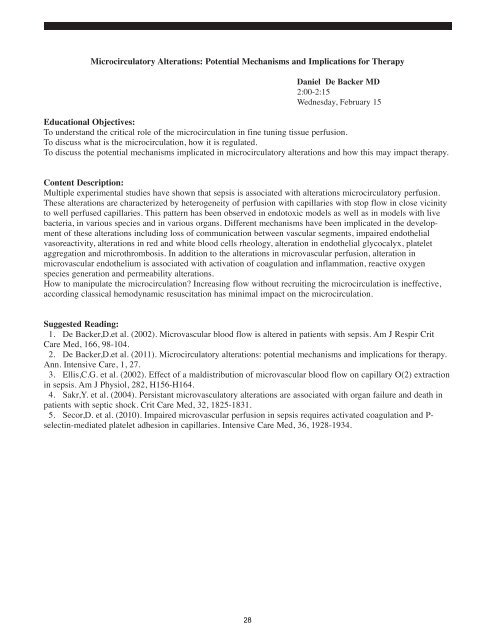ABSTRACTS from 16th International COnference on ... - CRRT Online
ABSTRACTS from 16th International COnference on ... - CRRT Online
ABSTRACTS from 16th International COnference on ... - CRRT Online
Create successful ePaper yourself
Turn your PDF publications into a flip-book with our unique Google optimized e-Paper software.
Microcirculatory Alterati<strong>on</strong>s: Potential Mechanisms and Implicati<strong>on</strong>s for Therapy<br />
Daniel De Backer MD<br />
2:00-2:15<br />
Wednesday, February 15<br />
Educati<strong>on</strong>al Objectives:<br />
To understand the critical role of the microcirculati<strong>on</strong> in fine tuning tissue perfusi<strong>on</strong>.<br />
To discuss what is the microcirculati<strong>on</strong>, how it is regulated.<br />
To discuss the potential mechanisms implicated in microcirculatory alterati<strong>on</strong>s and how this may impact therapy.<br />
C<strong>on</strong>tent Descripti<strong>on</strong>:<br />
Multiple experimental studies have shown that sepsis is associated with alterati<strong>on</strong>s microcirculatory perfusi<strong>on</strong>.<br />
These alterati<strong>on</strong>s are characterized by heterogeneity of perfusi<strong>on</strong> with capillaries with stop flow in close vicinity<br />
to well perfused capillaries. This pattern has been observed in endotoxic models as well as in models with live<br />
bacteria, in various species and in various organs. Different mechanisms have been implicated in the development<br />
of these alterati<strong>on</strong>s including loss of communicati<strong>on</strong> between vascular segments, impaired endothelial<br />
vasoreactivity, alterati<strong>on</strong>s in red and white blood cells rheology, alterati<strong>on</strong> in endothelial glycocalyx, platelet<br />
aggregati<strong>on</strong> and microthrombosis. In additi<strong>on</strong> to the alterati<strong>on</strong>s in microvascular perfusi<strong>on</strong>, alterati<strong>on</strong> in<br />
microvascular endothelium is associated with activati<strong>on</strong> of coagulati<strong>on</strong> and inflammati<strong>on</strong>, reactive oxygen<br />
species generati<strong>on</strong> and permeability alterati<strong>on</strong>s.<br />
How to manipulate the microcirculati<strong>on</strong>? Increasing flow without recruiting the microcirculati<strong>on</strong> is ineffective,<br />
according classical hemodynamic resuscitati<strong>on</strong> has minimal impact <strong>on</strong> the microcirculati<strong>on</strong>.<br />
Suggested Reading:<br />
1. De Backer,D.et al. (2002). Microvascular blood flow is altered in patients with sepsis. Am J Respir Crit<br />
Care Med, 166, 98-104.<br />
2. De Backer,D.et al. (2011). Microcirculatory alterati<strong>on</strong>s: potential mechanisms and implicati<strong>on</strong>s for therapy.<br />
Ann. Intensive Care, 1, 27.<br />
3. Ellis,C.G. et al. (2002). Effect of a maldistributi<strong>on</strong> of microvascular blood flow <strong>on</strong> capillary O(2) extracti<strong>on</strong><br />
in sepsis. Am J Physiol, 282, H156-H164.<br />
4. Sakr,Y. et al. (2004). Persistant microvasculatory alterati<strong>on</strong>s are associated with organ failure and death in<br />
patients with septic shock. Crit Care Med, 32, 1825-1831.<br />
5. Secor,D. et al. (2010). Impaired microvascular perfusi<strong>on</strong> in sepsis requires activated coagulati<strong>on</strong> and P-<br />
selectin-mediated platelet adhesi<strong>on</strong> in capillaries. Intensive Care Med, 36, 1928-1934.<br />
28
















